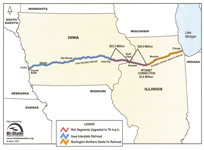 Passenger
rail to the Quad Cities is part of a larger discussion about how a
community moves its people. While our transportation policy most
often focuses on how to move automobiles
from one place to another, alternative transportation has frequently
been ignored.
Passenger
rail to the Quad Cities is part of a larger discussion about how a
community moves its people. While our transportation policy most
often focuses on how to move automobiles
from one place to another, alternative transportation has frequently
been ignored.
That's shifting. An aging population, traffic congestion, air-travel hassles, high fuel prices, and concern about global warming have all sparked renewed interest in mass-transit options such as passenger rail (getting from city to city) and commuter rail (transportation within a city).
And mass transit is gaining users. Since doubling its Amtrak support, Illinois in November and December saw train-ridership increases of nearly 50 percent compared to those months in 2005. And MetroLINK - Rock Island County's mass-transit authority - has seen its ridership grow 6 percent over the past two years.
"You want to have as many mobility options as possible," said Gena McCullough, planning director for the Bi-State Regional Commission. "The whole emphasis from the federal level to the local level is integrating your transportation system."
So while the Interstate 74 bridge over the Mississippi remains the top transportation priority in the Quad Cities, passenger and commuter rail projects are also high on the agenda.
Passenger rail is not an end in itself but one step toward a seamless transportation network. The idea is that a business traveler can arrive in the Quad Cities from Des Moines or Chicago and hop on another mass-transit option - either commuter rail or a rapid-transit bus - to arrive at his or her ultimate destination.
Right now, McCullough said, people are talking about passenger rail to Chicago "because there's more activity. [That's] where the funding is [most likely] available."
But things are moving on the commuter-rail angle, too. While the Iowa Quad Cities Transit Alternatives Analysis (completed last year) found that high-speed mass transit - such as light rail - would not be cost-effective in the Iowa Quad Cities, MetroLINK is still exploring the concept on the Illinois side.
The organization's Balanced Growth Project (http://qcmetrolink.com/whatsnew/balanced.php) includes a high-speed intracity component. The organization envisions some sort of rapid mass transit connecting the downtowns of Rock Island, Moline, and East Moline along the Mississippi River.
Jeff Nelson, MetroLINK's general manager, sees the rapid transit as "a thread to really tie our economic communities together." Roads serve that purpose now, but not efficiently; there's no single, easy-to-navigate road to take a person from downtown Rock Island to downtown East Moline.
Nelson said MetroLINK is looking for funding for the final part of a study for rapid transit. That will look at demand, potential usage, and costs of both light rail and bus rapid transit. Nelson called prospects for study funding "pretty good" and said he hopes the evaluation is finished in early 2008. He said that MetroLINK could be pushing for project funding in 2009. With a build-out of at least two years, he noted, the earliest the community would have that type of rapid transit would be 2012.
That means that the Quad Cities could be lobbying the state and federal governments for three major transportation projects in the coming years: an I-74 bridge, passenger rail, and intracity commuter rapid transit.
But those projects are funded from different sources, Nelson said, and other communities have simultaneously undertaken major transportation initiatives and gotten them funded and built.
Nelson said a rail connection to Chicago is most important among the things that the Quad Cities is considering but noted that rapid transit has the opportunity to help downtowns in the Illinois Quad Cities increase their population densities.
An integrated transportation system will bring people to the central city, concentrating them near transportation hubs. "We see density as not being bad," Nelson said.










